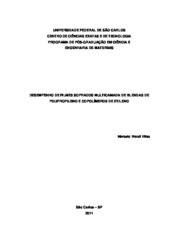| dc.contributor.author | Elias, Marcelo Brasil | |
| dc.date.accessioned | 2016-06-02T19:10:11Z | |
| dc.date.available | 2012-10-22 | |
| dc.date.available | 2016-06-02T19:10:11Z | |
| dc.date.issued | 2012-08-30 | |
| dc.identifier.citation | ELIAS, Marcelo Brasil. Performance of multilayer blown films of polypropylene and ethylene copolymers blends. 2012. 242 f. Tese (Doutorado em Ciências Exatas e da Terra) - Universidade Federal de São Carlos, São Carlos, 2012. | por |
| dc.identifier.uri | https://repositorio.ufscar.br/handle/ufscar/697 | |
| dc.description.abstract | Polypropylene (PP) and polyethylene (PE) are widely used in the flexible packaging market individually as mono or multilayer films. Blending PP and PE in coextruded films has shown limited commercial applications due to the poor adhesion. On this work we made three layer coextruded blown films with ascendant flow and air cooling. The thicknesses were kept constant at 50m, having the external layers made of metallocene ethylene-octene copolymers (m-PE) to provide sealability. The internal layer (structural) was produced with rich blends of polypropylene homopolymer and ethylene-octene copolymers made by metallocene (m-PE and POP) and by Ziegler-Natta (U-PE) catalytic systems. These films were characterized by their mechanical, thermal, optical and morphological properties. Based on the results it is proposed a morphological model of the core layer, in which the matrix phase of PP has a shish kebab crystalline structure, and the disperse phase and the external layers composed by fragmented lamellar crystallites blended with small spherulites. The epitaxial crystallization of the polyethylene copolymer on the shishes of the polypropylene allows good adhesion between the external and internal layers of the multilayered structure. The internal structure formed with the dispersed phase of m-PE and U-PE has shown similar mechanical behavior with better properties at the concentration of 30%.On the other hand, when the dispersed phase of the internal layer is POP elastomer, the Tg and Tm of the matrix PP decrease due the compatibility between the matrix and the dispersed phase, generating shish kebab structures with lower crystallinity. These morphological characteristics guarantee a balanced film regarding the thermomechanical properties, in order to achieve a high performance flexible packaging. | eng |
| dc.format | application/pdf | por |
| dc.language | por | por |
| dc.publisher | Universidade Federal de São Carlos | por |
| dc.rights | Acesso Aberto | por |
| dc.subject | Polipropileno | por |
| dc.subject | Adesão | por |
| dc.subject | Cristalização | por |
| dc.subject | Polietileno | por |
| dc.title | Desempenho de filmes soprados multicamada de blendas de polipropileno e copolímeros de etileno | por |
| dc.title.alternative | Performance of multilayer blown films of polypropylene and ethylene copolymers blends | |
| dc.type | Tese | por |
| dc.contributor.advisor1 | Canevarolo Júnior, Sebastião Vicente | |
| dc.contributor.advisor1Lattes | http://genos.cnpq.br:12010/dwlattes/owa/prc_imp_cv_int?f_cod=K4781975Z6 | por |
| dc.description.resumo | O polipropileno (PP) e o polietileno (PE) são amplamente utilizados no mercado de embalagens flexíveis na forma individualizada de filmes monocamada ou co-extrudados multicamadas. Misturas de PP e PE em filmes co-extrudados tem apresentado resultados de pouca aplicação comercial devido a problemas de adesão. Neste estudo foram produzidos filmes com três camadas co-extrudados tubulares soprados com fluxo ascendente e resfriamento por ar. Estes apresentam espessura total de 50mm, sendo que as camadas externas são compostas de copolímeros de etileno-octeno metalocêno (m-PE) para garantir a soldabilidade do filme. A camada coextrudada central, dita estrutural, foi produzida com misturas ricas de polipropileno homopolímero com copolímeros de etileno-octeno via metalocêno (m-PE e POP) e Ziegler-Natta (U-PE). Estes filmes foram caracterizados com relação as suas propriedades mecânicas, térmica, ótica e morfológica. Com base nestes resultados foi proposto um modelo morfológico para a camada central, onde a fase matriz de PP forma estruturas cristalinas do tipo shish kebab e a fase dispersa e as camadas externas formam cristalitos lamelares fragmentados e pequenos esferulitos. A cristalização epitaxial dos copolímeros de polietileno sobre os shishes do polipropileno provê a boa adesão entre as camadas externa-interna da estrutura multi-camada. A estrutura central formada com fase dispersa de m-PE e U-PE apresentaram comportamentos mecânicos similares sendo estes maximizados na concentração de 30%. Por outro lado quando a fase dispersa da camada central é formada por POP a Tg e Tm do polipropileno matriz são reduzidas, função da compatibilidade entre fase matriz e fase dispersa, gerando pequenas estruturas do tipo shish kekab, com baixa cristalinidade. O conjunto de tais características morfológicas garantem um equilíbrio de propriedades termo-mecânicas, necessárias em uma embalagem flexível de alto desempenho. | por |
| dc.publisher.country | BR | por |
| dc.publisher.initials | UFSCar | por |
| dc.publisher.program | Programa de Pós-Graduação em Ciência e Engenharia de Materiais - PPGCEM | por |
| dc.subject.cnpq | ENGENHARIAS::ENGENHARIA DE MATERIAIS E METALURGICA | por |
